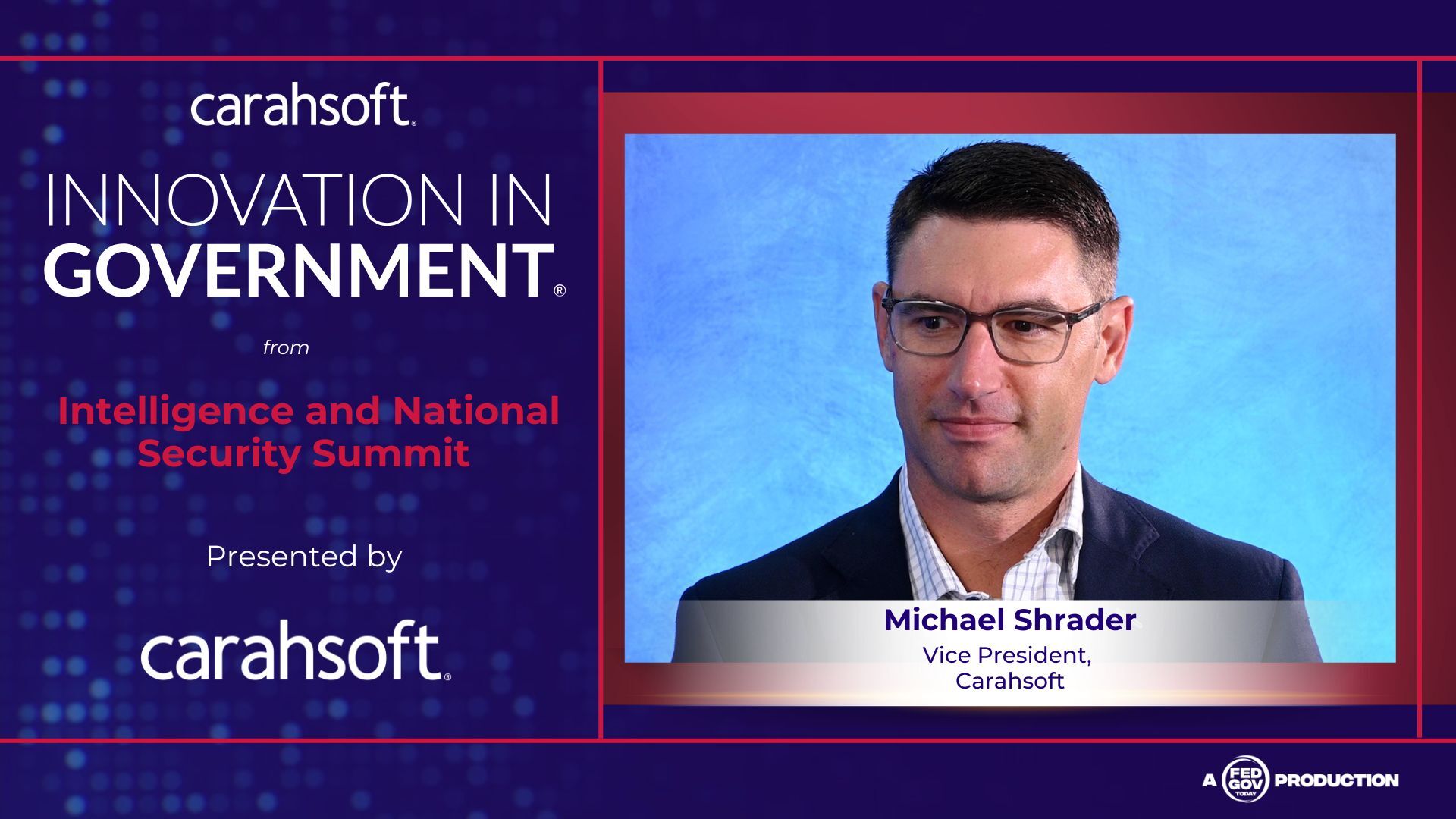Original Broadcast 4/29/25
Presented by Carahsoft
In this episode of Innovation in Government, recorded live at Sea-Air-Space 2025, host Francis Rose explores the strategic imperatives of modernization and lethality shaping today’s maritime services. Leaders from the U.S. Coast Guard, U.S. Marine Corps, and top defense technology companies share how they’re implementing cutting-edge solutions to ensure mission readiness. Topics range from recapitalizing aging fleets and reimagining military training to adopting artificial intelligence, securing operational technologies, and building more resilient and intelligent infrastructure. Together, these voices paint a picture of a collaborative ecosystem innovating at speed to meet the evolving demands of sea service missions.
Recapitalizing the Coast Guard for the Future
 Rear Admiral Matt Lake, Assistant Commandant for Resources & Chief Financial Officer at the U.S. Coast Guard explains the service’s strategic imperative to modernize its aging fleet while sustaining frontline operations. With 85% of the Coast Guard’s $13 billion budget allocated to operations and sustainment, Lake underscores the urgent need to invest the remaining resources in recapitalizing ships—some dating back to the 1960s. He shares insights on a recent rapid procurement of a commercially available icebreaker, achieved with congressional support and accelerated acquisition strategies. He also discusses infrastructure investments in locations like Charleston and Seattle, designed to support incoming vessels, and the importance of long-term affordability in budgeting.
Rear Admiral Matt Lake, Assistant Commandant for Resources & Chief Financial Officer at the U.S. Coast Guard explains the service’s strategic imperative to modernize its aging fleet while sustaining frontline operations. With 85% of the Coast Guard’s $13 billion budget allocated to operations and sustainment, Lake underscores the urgent need to invest the remaining resources in recapitalizing ships—some dating back to the 1960s. He shares insights on a recent rapid procurement of a commercially available icebreaker, achieved with congressional support and accelerated acquisition strategies. He also discusses infrastructure investments in locations like Charleston and Seattle, designed to support incoming vessels, and the importance of long-term affordability in budgeting.
Key Takeaways:
-
Many Coast Guard cutters are over 60 years old, underscoring urgent recapitalization needs.
-
Agile acquisition enabled a rapid icebreaker purchase to strengthen Arctic capabilities.
-
Infrastructure upgrades are clustered around major ports to support new assets and aircraft.
Enhancing Supply Chain Resilience at Sea
 Dan Miller, Director of Defense Solutions of SAP Public Services explains how supply chain resilience is improving thanks to multi-tier visibility and real-time data sharing across distributed naval operations. By integrating supply chain data from prime contractors to subcontractors and down to ship-level needs, maritime services are minimizing delays and maintaining readiness. Miller emphasizes the importance of governance and accurate system-of-record data to avoid data loss and inefficiencies, with AI and automation offering key improvements in speed and accuracy.
Dan Miller, Director of Defense Solutions of SAP Public Services explains how supply chain resilience is improving thanks to multi-tier visibility and real-time data sharing across distributed naval operations. By integrating supply chain data from prime contractors to subcontractors and down to ship-level needs, maritime services are minimizing delays and maintaining readiness. Miller emphasizes the importance of governance and accurate system-of-record data to avoid data loss and inefficiencies, with AI and automation offering key improvements in speed and accuracy.
Key Takeaways:
-
Multi-tier visibility and secure collaboration strengthen supply chain operations.
-
Data governance and clean records are critical to ensuring material availability.
-
AI enables faster decision-making and continuous system updates for shipboard operations.
Leveraging AI for Maritime Innovation
 Charles “Skip” Farmer, Sr. Director Sales Engineering of Primer highlights how maritime organizations are rapidly expanding use cases for artificial intelligence. Initially applied to back-office tasks, AI is now enhancing mission planning, contested logistics, and warfighter decision-making. Farmer stresses that faster, more trusted data analysis is improving operational tempo and that organizations are now solving real-world challenges with AI rather than simply experimenting with it.
Charles “Skip” Farmer, Sr. Director Sales Engineering of Primer highlights how maritime organizations are rapidly expanding use cases for artificial intelligence. Initially applied to back-office tasks, AI is now enhancing mission planning, contested logistics, and warfighter decision-making. Farmer stresses that faster, more trusted data analysis is improving operational tempo and that organizations are now solving real-world challenges with AI rather than simply experimenting with it.
Key Takeaways:
-
AI is transitioning from support roles to operational decision-making tools.
-
Large volumes of historic data are being mined for actionable insights.
-
Trust in AI outputs has increased significantly as reliability improves.
Financial Resilience Through Data and Automation
 Brian Campo, Dep Asst Commandant for C4 & IT, DCIO at the Coast Guard outlines the service’s strategy for building a data-driven decision ecosystem around its new financial management system. He explains how data teams—including mission owners and scientists—are curating legacy data and delivering real-time, authoritative information. Campo also describes how robotic process automation (RPA) delivered significant time and cost savings, and how the Coast Guard is exploring agent-based AI tools to extend automation benefits enterprise-wide.
Brian Campo, Dep Asst Commandant for C4 & IT, DCIO at the Coast Guard outlines the service’s strategy for building a data-driven decision ecosystem around its new financial management system. He explains how data teams—including mission owners and scientists—are curating legacy data and delivering real-time, authoritative information. Campo also describes how robotic process automation (RPA) delivered significant time and cost savings, and how the Coast Guard is exploring agent-based AI tools to extend automation benefits enterprise-wide.
Key Takeaways:
-
Interdisciplinary data teams are producing authoritative data products for decision-making.
-
RPA saved 200,000 hours in its first year, yielding unmatched ROI.
-
The Coast Guard is aiming to deploy agent-based AI to the desktop level by 2027.
Driving Speed and Relevance with AI Tools
 Jared Smith, Senior Account Executive DoD - USN at Elastic discusses how AI and machine learning are enabling the sea services to reduce analysis time from hours to minutes, greatly enhancing decision-making speed. Smith points to a shift in culture, where organizations now identify specific problems and seek technologies to solve them. He also emphasizes how direct collaboration between industry and end users is leading to more relevant, effective technology adoption.
Jared Smith, Senior Account Executive DoD - USN at Elastic discusses how AI and machine learning are enabling the sea services to reduce analysis time from hours to minutes, greatly enhancing decision-making speed. Smith points to a shift in culture, where organizations now identify specific problems and seek technologies to solve them. He also emphasizes how direct collaboration between industry and end users is leading to more relevant, effective technology adoption.
Key Takeaways:
-
Massive datasets are now processed quickly to support near real-time decision-making.
-
End users are central to shaping technology solutions that directly improve operations.
-
Industry is more frequently working side-by-side with users to deliver mission impact.
Building Agile Public-Private Partnerships
 Joe Merrill, Senior Enterprise Account Exec at Vector Solutions Federal explores how government and industry can form more productive partnerships through openness and flexibility. He notes that while military systems are often rooted in decades-old business processes, progress comes when both sides are willing to adapt. Merrill calls on government leaders to be more responsive to outreach from solution providers and highlights the need for thoughtful integration of commercial tools into military environments.
Joe Merrill, Senior Enterprise Account Exec at Vector Solutions Federal explores how government and industry can form more productive partnerships through openness and flexibility. He notes that while military systems are often rooted in decades-old business processes, progress comes when both sides are willing to adapt. Merrill calls on government leaders to be more responsive to outreach from solution providers and highlights the need for thoughtful integration of commercial tools into military environments.
Key Takeaways:
-
Flexibility and open communication foster stronger government-industry partnerships.
-
Industry can offer targeted expertise, especially in specialized mission areas like training.
-
Government leaders must be more open to timely engagement with potential partners.
Training for the Modern Fight with Project Tripoli
 Lieutenant General Benjamin Watson, Commanding General, Training and Education Command at USMC explains how the Marine Corps is modernizing its training with Project Tripoli, a Live, Virtual, Constructive (LVC) environment that complements physical ranges. He details how the Corps is training for modern capabilities—like cyber and electromagnetic spectrum warfare—using simulations that surpass the limits of live training. Watson also outlines Project Trident, which deepens naval integration, and Project Triumph, which modernizes education through outcome-based learning.
Lieutenant General Benjamin Watson, Commanding General, Training and Education Command at USMC explains how the Marine Corps is modernizing its training with Project Tripoli, a Live, Virtual, Constructive (LVC) environment that complements physical ranges. He details how the Corps is training for modern capabilities—like cyber and electromagnetic spectrum warfare—using simulations that surpass the limits of live training. Watson also outlines Project Trident, which deepens naval integration, and Project Triumph, which modernizes education through outcome-based learning.
Key Takeaways:
-
LVC environments are essential to preparing Marines for modern, multidomain operations.
-
Project Trident advances integration of Navy and Marine Corps maritime fires doctrine.
-
Project Triumph uses AI and modern instructional methods to tailor learning experiences.
Protecting Supply Chains from Cyber Threats
 Ed Zaleski, Director of Sales, DOD at Synack warns that cyber adversaries may manipulate logistics and supply chain data to disrupt operations subtly. He emphasizes the importance of assuming breaches have occurred and rigorously testing for vulnerabilities. Zaleski argues that traditional compliance is insufficient and promotes a combination of human-led and automated testing to ensure systems meet both security and operational integrity requirements.
Ed Zaleski, Director of Sales, DOD at Synack warns that cyber adversaries may manipulate logistics and supply chain data to disrupt operations subtly. He emphasizes the importance of assuming breaches have occurred and rigorously testing for vulnerabilities. Zaleski argues that traditional compliance is insufficient and promotes a combination of human-led and automated testing to ensure systems meet both security and operational integrity requirements.
Key Takeaways:
-
Subtle data manipulation in logistics poses a major operational risk.
-
Zero-trust environments require continuous testing, not just compliance certification.
-
Combining automated tools with human insight enhances cybersecurity effectiveness.
Securing Legacy Infrastructure in the Digital Age
 Guy Shinnar, VP Sales America at Waterfall Security Solutions addresses the growing challenge of securing aging OT infrastructure while enabling data sharing. He describes how segmented architectures and unidirectional gateways can provide robust protection without overhauling existing systems. Shinnar also highlights how increasing awareness and urgency across the DoD are fueling momentum toward stronger data governance and cyber resilience.
Guy Shinnar, VP Sales America at Waterfall Security Solutions addresses the growing challenge of securing aging OT infrastructure while enabling data sharing. He describes how segmented architectures and unidirectional gateways can provide robust protection without overhauling existing systems. Shinnar also highlights how increasing awareness and urgency across the DoD are fueling momentum toward stronger data governance and cyber resilience.
Key Takeaways:
-
Many OT systems cannot be updated and must be secured through architectural segmentation.
-
Data sharing can be enabled safely without exposing core operational environments.
-
Strategic architectural planning is essential to long-term resilience and modernization.
Building Readiness Through Better Barracks
 Major General Jason Woodworth, Commander, MCICOM / Asst. Dep. Cmdt., I&L (Facilities) at USMC shares how the Marine Corps is prioritizing barracks upgrades through its Barracks 2030 initiative. Framing it as both a quality-of-life and readiness initiative, Woodworth explains how improving living conditions directly supports mental resilience and operational preparedness. He also notes the importance of communications infrastructure on base to support both mission and morale.
Major General Jason Woodworth, Commander, MCICOM / Asst. Dep. Cmdt., I&L (Facilities) at USMC shares how the Marine Corps is prioritizing barracks upgrades through its Barracks 2030 initiative. Framing it as both a quality-of-life and readiness initiative, Woodworth explains how improving living conditions directly supports mental resilience and operational preparedness. He also notes the importance of communications infrastructure on base to support both mission and morale.
Key Takeaways:
-
Barracks 2030 ensures Marines live in secure, healthy environments that support readiness.
-
Family support and housing affordability are key elements of total force resilience.
-
Upgraded communications grids are vital to secure operations and personal connectivity.



